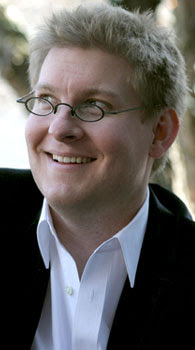 Sunday evening, fortepianist Kristian Bezuidenhout presented a charming program of Classical works in the elegant Music Room of Georgetown’s Dumbarton Oaks (you can listen to him play on NPR). The foremost fortepianist of his generation, the native South African (b. 1979) soared through his studies at the Eastman School of Music and secured an astonishing First Prize and Audience Prize at the 2001 Bruges Fortepiano Competition. His Mozart concerti performances with the Orchestra of the 18th century at Amsterdam’s Muziekgebouw a few years back had people predicting greatness. For this concert on the Friends of Music subscription series, Bezuidenhout offered a balanced program of Mozart, Haydn, and Georg Benda (1722-1795).
Sunday evening, fortepianist Kristian Bezuidenhout presented a charming program of Classical works in the elegant Music Room of Georgetown’s Dumbarton Oaks (you can listen to him play on NPR). The foremost fortepianist of his generation, the native South African (b. 1979) soared through his studies at the Eastman School of Music and secured an astonishing First Prize and Audience Prize at the 2001 Bruges Fortepiano Competition. His Mozart concerti performances with the Orchestra of the 18th century at Amsterdam’s Muziekgebouw a few years back had people predicting greatness. For this concert on the Friends of Music subscription series, Bezuidenhout offered a balanced program of Mozart, Haydn, and Georg Benda (1722-1795).Following an intimate rendition of Mozart’s Sonata in F Major, KV 533/494, Bezuidenhout informally made known to the audience that the composer’s sonatas were “only for amateur girls in the salons.” Mozart apparently reserved his concertos, fantasties, and variations for public performance, the latter two often improvised on the spot. Cleverly, Mozart’s deep Fantasie in C Minor, KV 475, was next on the program. Highly improvisatory in approach, Bezuidenhout added fermatas to the first note of the opening octave figures, throwing them drastically out of tempo, though adding an undeniably large dose of fantasy. Surely the performer has an argument for this approach, likely stemming from the footnote in the Bärenreiter edition stating: “Bar 1: the slurring follows the text of the first edition (Artaria, Vienna, 1785); in his handwritten thematic catalogue, Mozart begins the slur from the second note.” Bezuidenhout took the opportunity to ornament on repeats, while creating great contrasts between Adagio and Allegro sections – possibly too much.
The basic approach to this work is to play it proportionally, like a Renaissance building, i.e., with all sections in the same tempo with correlating relationships. For example, the Allegro section is double the tempo of the opening Adagio (4/4); the Andantino section (3/4) is a proportion of the base tempo, etc. It is difficult to argue with Bezuidenhout’s free approach in this work, as he framed its performance as an improvised fantasy, not as a balanced structure. However, the musical skeleton these tempo relationships can create adds strength to the work as a whole; Bezuidenhout’s performance seemed somewhat fragmented, and the tumult of the Più allegro section lacked bite.
Haydn’s Variations in F minor (“Un piccolo Divertimento,” Hob. XVII:6) was very conversational, relaxed, and clear, while variations with the moderator (mute) demanded the audience to listen closely. Georg Benda’s perky Sonata in A minor reminded one of the works of C.P.E. Bach, though much more fun. Mozart’s Variations in G Major on “Unser dummer Pöbel meint” (KV 455) featured phrases that melted away and natural playing by a performer who humbly presents music before himself.
Disappointingly, Bezuidenhout’s only other American performance in 2008 will be a single engagement in New York this December. By contrast, his full European and Asian docket includes a tour with violinist Viktoria Mullova, the complete Beethoven Concertos with Frans Brüggen and the Orchestra of the 18th Century at the Concertgebouw, and a tour of China with that orchestra. We hope to see him back in the Washington area soon.
The next concert on the Friends of Music series at Dumbarton Oaks will feature the Fine Arts Quartet and Brazilian pianist Christina Ortiz (March 9 and 10, 8 pm).
No comments:
Post a Comment